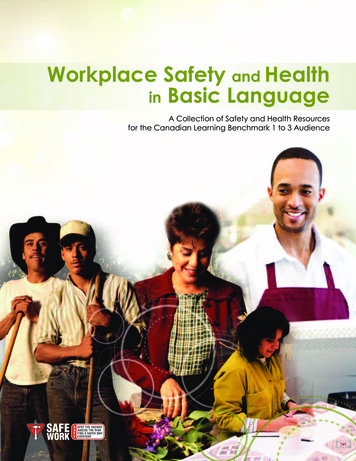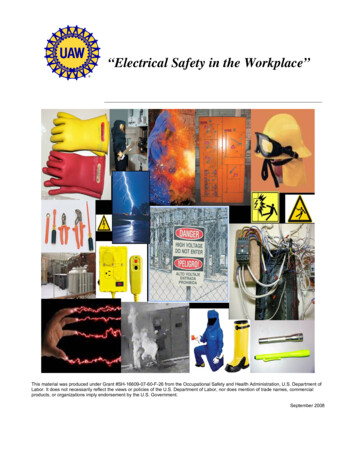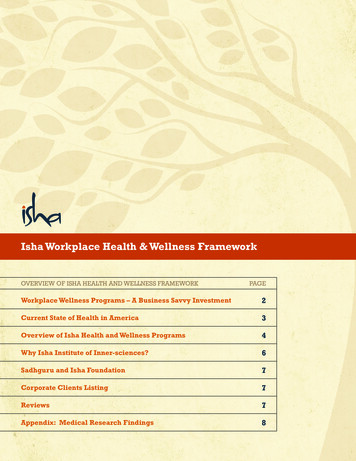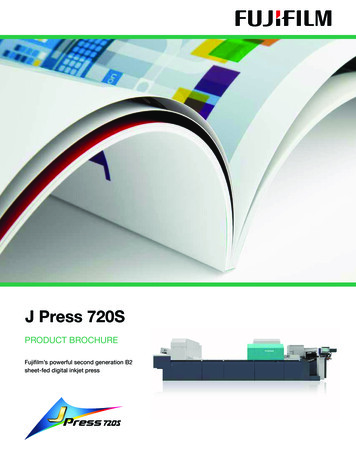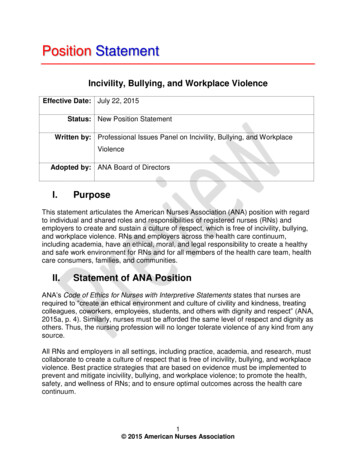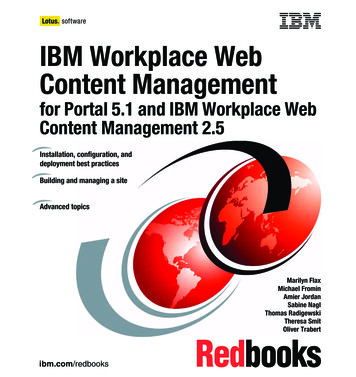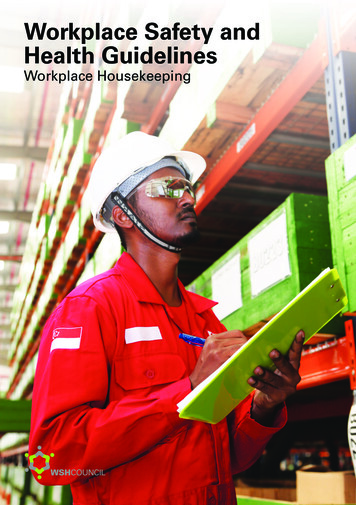
Transcription
Workplace Safety andHealth GuidelinesWorkplace Housekeeping
Contents1.1.11.21.31.4IntroductionGood Housekeeping BasicsResponsibility for HousekeepingOutdoor HousekeepingRelevant WSH 2.4.42.4.55S Concept and HousekeepingWhat is 5S?Why Practice 5S?Management’s Role in 5S ImplementationImplementing 5S5S-1 Sort5S-2 Straighten (Set in Order)5S-3 Shine5S-4 Standardise5S-5 Sustain090910101212141921233.Good Housekeeping and WSH274.Examples of Good Housekeeping355.Housekeeping Inspection Checklist416.References437.AnnexAnnex A: Key Steps to 5S ImplementationAnnex B: Sample 5S Audit Check Sheet4445Acknowledgements488.Year of issue: 2016
1. IntroductionHousekeeping is relevant in all workplaces—whether at the office, factory, shipyard,construction site, storage facility, hospital, laboratory, retail shop or industrial kitchen.Effective housekeeping can eliminate many workplace hazards and help get work done safelyand properly. A clean and tidy workplace also enhances a company’s image and providesimmediate visible evidence of its commitment towards workplace safety and health (WSH).Housekeeping is not just about the cleanliness of a workplace. It is also about keepingworkplaces in order. Workplace housekeeping may be defined as activities undertaken tocreate or maintain an orderly, clean, tidy, and safe working environment.Good housekeeping entails the effective organisation of the workplace and it contributes tobetter WSH performance, increased productivity and better quality control. It also includesgood workplace traffic management, proper storage of raw materials and finished goods, neatand tidy work areas as well as adequate workplace illumination (see Chapter 3 for a listing ofvarious housekeeping aspects). With good housekeeping practices, workplaces can be keptsafe from potentially dangerous objects or substances present in the work environment. Anorganised and clutter-free work area also makes it easier to respond to or evacuate in the eventof an emergency.Good housekeeping can result in: more effective use of space; better inventory control of tools and materials; reduced handling to ease the flow of materials; more efficient equipment clean-up and maintenance; reduced equipment and property damage through better preventive maintenance; more hygienic workplace conditions that would lead to improved workers’ health; improved overall look and feel of work environment; and improved staff morale and wellbeing.Poor housekeeping, on the contrary, creates workplace hazards that can lead to variousaccident types like Slips, Trips and Falls (STF), Caught In-between Objects (CIBO), Struck byFalling Objects (SBFO), Struck by Moving Objects (SBMO), Cut/ Stabbed by Objects (CSBO) andStruck against Objects (SAO). Additionally, poor housekeeping may create fire hazards thatinevitably lead to increased fire risk.3
Examples of workplace accidents caused by poor housekeeping: slipping on a spilled substance or oily, wet or dirty surfaces; tripping over loose objects on floors, stairs and platforms; striking against protruding, improperly stacked or misplaced items; being hit by objects falling from a high shelf or the top of a cupboard; and being cut or punctured by a protruding nail or sharp object.Over and above being a useful tool for productivity and quality management, companies inSingapore are also increasingly recognising housekeeping as an important way to reduceworkplace accidents and injuries.This guide introduces the 5S concept of housekeeping and how it can be used toenhance WSH and improve workplace efficiency and productivity at the same time. Goodhousekeeping initiatives support WSH culture-building efforts and can be used to enhance the“Ownership and Teamwork” attribute of the WSH CultureSAFE Model.1.1Good Housekeeping Basics1.2Responsibility for HousekeepingGood housekeeping is everyone’s responsibility. Keeping a workplace safe, clean and clutterfree is an ongoing activity in which all employees have to do their part (see Table 1).Housekeeping Responsibilities1. Prevent slips, tripsand falls.2. Limit spills.3. Ensure machine safety.There are three key factors to good housekeeping. They are:1. Overall cleanliness and orderlinessNo matter the level of occupancy, a company can improve the conduciveness, hygiene andsafety of its work environment by keeping all its work areas clean, organised and uncluttered.This can be achieved through regular housekeeping, timely disposal or removal of itemsthat are seldom used or no longer needed.2. Adequate space and proper layoutWork activity requires space and the presence of people, equipment and materialstend to obstruct orderly movement throughout the premises. A careful review of spacerequirements based on actual operations may suggest ways for a better layout. A welldesigned work space with equipment arranged for optimum workflow will improveefficiency and productivity, as well as the ease with which work activities can be carried out.3. Correct storage and materials handlingProper storage and handling equipment (e.g., engineered shelving, forklifts, handlingrobots, and conveyor systems) are necessary to facilitate the movement and placementof materials in a factory, construction site or storage facility. This will prevent haphazardstorage which can lead to blocked exit paths and/ or obstructed access to fire controlequipment (e.g., fire extinguishers, fire hose reels). Poorly organised storage may alsoresult in the accumulation of unwanted items, debris and/ or waste materials especiallyin any available vacant space.4. Prevent fires.5. Ensure exits andaccess routes to fireequipment are clear. Do not stack items along walkways or passageways; Put away electrical cords and water or air hoses; and Put away tools and keep drawers closed. Clean up spills immediately; Repair leaks as soon as possible; and Sweep up debris. Inspect machines and ensure that all guards are inplace before use; Keep area around machines clear; Put away tools; and Clean machines regularly. Store flammable or combustible liquids in labelled andclosed containers; Keep flammable or combustible materials away fromsources of ignition; Keep electrical equipment clean; and Inspect electrical cords before use. Do not block emergency exits; Keep evacuation routes clear; Check that fire extinguishers are accessible; and Ensure that electrical panels can be opened.Table 1: Examples of housekeeping responsibilities.Good housekeeping will ensue once all the above factors are addressed. A neat and tidyworkplace can be achieved and sustained when a routine is established for each factor.45
Housekeeping may require expert knowledge and a good understanding of the workflow andactivities to be carried out. As an example, consider an operating theatre where surgery is to beperformed. While the theatre support staff and operating room technicians can help to prepareand tidy up the operating theatre, it is the surgeon and operating room nurses who decide thetools and equipment required and how these should be arranged for a successful operation.From the above example, it can be seen that active participation from various teams ofemployees is required for housekeeping to be effective. Companies will need to providethe necessary resources (e.g., time and supporting infrastructure) and develop a disciplinedand systematic approach to housekeeping so that employees will be able to carry out theirhousekeeping duties as part of daily routine.1.3Outdoor HousekeepingGood housekeeping is important outdoors as it is indoors (i.e., inside a building or home). Goodhousekeeping not only reduces workplace accidents and injuries; it is also a critical aspect offire safety.Outdoor storage areas should be located at sufficient separation distances from buildings andother combustible storage to prevent fire spread. This is because the accumulation of storeditems (including waste) can present a fire load sufficient to cause damage to buildings as wellas outdoor facilities and equipment. Housekeeping focuses on maintaining the separation byprohibiting even the temporary introduction of structures or objects such as shelters, discardedcrates, or other combustibles.If materials and equipment are stored outdoors, good housekeeping requires that combustiblesand obstructions are kept out of the passageways between storage piles. Keeping passagewaysclear will allow easy access for firefighting in the event one breaks out.Proper housekeeping also requires the prohibition of smoking in areas used for outdoorstorage of flammable materials. Companies should provide suitable warning signs and noncombustible receptacles for smokers to dispose smoking materials before entering a “NoSmoking” zone.The regular inspection of work premises and subsequent correction of irregularities are partof good housekeeping. Irregularities may refer to situations that are not right (e.g., a blockedpassageway) or things that are out of place (e.g., a misplaced tool).For more information on housekeeping and outdoor storage, see6 Fire Safety (Petroleum and Flammable Materials) Regulations; Fire Safety Guidelines for Open Plant Structures in Oil, Chemical and Process Industries Singapore Civil Defence Force Fire Code 2013; SS 532: 2007 Code of Practice for the Storage of Flammable Liquids; SS 586 1: 2014 Specification for Hazard Communication for Hazardous Chemicals andDangerous Goods Part 1 : Transport and Storage of Dangerous Goods; and WSH Guidelines on Flammable Materials.1.4Relevant WSH LegislationApplicable legislation associated with housekeeping:1. The WSH Act states that it is the duty of the occupier of the workplace to take, as far as it isreasonably practicable, measures to ensure that (i) the workplace, (ii) all means of access toor egress from the workplace, and (iii) any machine, equipment, plant, article or substancekept on the workplace are safe and do not cause health risk to any person within thosepremises, whether or not the person is at work or is an employee of the occupier.2. The WSH (Risk Management) Regulations requires the employer, self-employed person andprincipal to take all reasonably practicable steps to eliminate or minimise any foreseeablerisk to any person who may be affected by his or her undertaking in the workplace.3. The WSH (General Provisions) Regulations require all goods, articles and substances whichare stored, stacked or placed in a workplace to be stored, stacked or placed in a mannerthat does not interfere with (i) the adequate distribution of natural or artificial light, (ii) theproper operation of any machine or equipment, (iii) the unobstructed use of passagewaysor traffic lanes, and (iv) the efficient functioning of sprinkler systems or the use of other firefighting equipment.4. The WSH (Construction) Regulations 2007 stipulates the following:(i) Storage and placement of materials and equipmentIt is the duty of the employer or principal to ensure that material or equipment is notstored, stacked or placed so close to any opening or edge of a floor, scaffold, platformor structure to endanger persons below the opening or edge.(ii)Protection against falling objectsIt is the duty of the occupier to ensure that adequate overhead protection is providedat the worksite against objects that could fall on or otherwise hit persons.(iii) Slipping hazardsIt is the duty of the employer or principal to ensure that the passageway, scaffold,platform or other elevated working surface to be used by workers is kept free fromslipping hazards.(iv) Hazards arising from protruding objectsIt is the duty of the occupier to ensure that:a.All passageways, stairs, platforms and other means of access or places of workin the worksite are kept free from debris or protruding objects or any otherobstruction that could cause tripping; andb.(v)Any sharp projection present in any passageway, stair, platform and other meansof access or place of work in the worksite that may injure any person is removedor otherwise made safe.Accumulation of debrisIt is the duty of the occupier to ensure that debris shall not be allowed to accumulateso as to constitute a hazard in the worksite.7
5. The WSH (Shipbuilding and Ship-repairing) Regulations 2008 stipulates the following:(i) Slipping hazardsWhere any work is carried out by any person in a shipyard or on board a ship in aharbour, it is the duty of the responsible person to ensure that any passageway,scaffold, platform or other elevated working surface to be used by workers is kept freefrom slipping hazard.(ii)Hazards arising from protruding objectsWhere any work is carried out in a shipyard or on board a ship in a harbour, it is theduty of the responsible person to ensure that:a.All passageways, stairs, platforms and other means of access or places of workare kept free from debris or protruding objects or any other obstructions thatcould cause tripping; andb.Any sharp projection that is present in any passageway, stair, platform and othermeans of access or place of work which may injure any person is removed orotherwise made safe.(iii) Disposal of debrisWhere any work is carried out in a shipyard or on board a ship in a harbour, it is theduty of the responsible person to ensure that no debris is allowed to accumulate so asto constitute a hazard.2. 5S Concept and HousekeepingMany associate the concept of 5S with housekeeping. In actuality, while a 5S programmecan be used to achieve good housekeeping, it can be used for much more. 5S is essentially aworkplace organisation method used to achieve productivity, quality and WSH improvementin any type of business. This chapter briefly introduces the concept of 5S and how companiescan implement a 5S programme.2.1What is 5S?5S is a workplace organisation method based on a Japanese quality management conceptcompanies may use to achieve a clean and organised workplace. Through a systematicapproach, 5S offers opportunities fo
Housekeeping Inspection Checklist 6. References 7. Annex Annex A: Key Steps to 5S Implementation Annex B: Sample 5S Audit Check Sheet 8. Acknowledgements Year of issue: 2016. 3 Housekeeping is relevant in all workplaces—whether at the office, factory, shipyard, construction site, storage facility, hospital, laboratory, retail shop or industrial kitchen. Effective housekeeping can eliminate .
